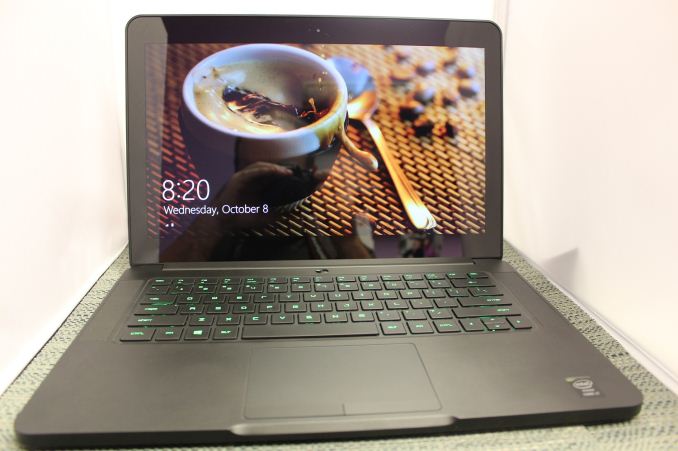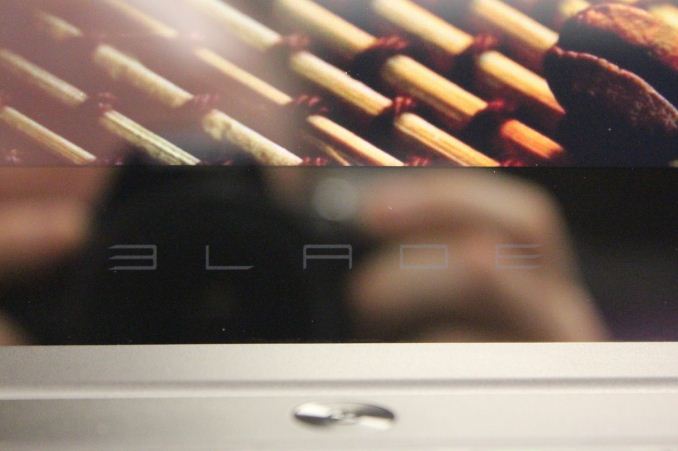The 2014 Razer Blade Review
by Brett Howse on October 10, 2014 9:00 AM EST- Posted in
- Notebooks
- Gaming
- Laptops
- Razer Blade
Final Words
The 2013 Razer Blade was a fantastic notebook computer with an abysmal display. For 2014, Razer has put one of the best displays we have ever tested in a laptop into the Blade, and it truly completes the experience. Razer’s slogan is “For Gamers, by Gamers” and we have to first evaluate the Razer Blade as a gaming laptop. Here it succeeds almost completely.
With a quad-core Intel Core i7 and an NVIDIA GeForce GTX 870M, there is a lot of processing power. The 14 inch Blade runs with larger gaming systems in our benchmarks, and it does all of this without throttling under load. It does get hot, but for the most part it is not hot where you will be touching it.
The high PPI display also looks fantastic when gaming at the native resolution, but the 3200x1800 resolution certainly taxes the available GPU power, and in order to push almost 6 million pixels some of the effects in games will need to be turned down. Luckily this is generally a very easy process for a lot of games due to the GeForce Experience software. If the game you want to play is not in the NVIDIA database though, expect some trial and error to find a frame rate and graphical quality that works for you. Perhaps a 2015 refresh of the system with the GTX 970M will be the solution to this.
If you are looking for a powerful, portable, well-built gaming laptop, you would be hard pressed to find something more pleasing for the task. There are faster systems out there, but they are generally larger and heavier, so you would lose the portability of a 14 inch system. In the past, gaming laptops were meant to move from one table to another, but the Razer Blade has shown that this does not need to be the case.
Portability is one of the biggest aspects of the 2014 Razer Blade. The CNC aluminum body is thin and light. Yet inside is a 70 Wh battery that allows the Blade to be used unplugged from the mains for a reasonable amount of time. Battery life is not record setting, but considering the amount of performance inside and the high PPI display, it is generally adequate.
When you have a system of this quality and price, you have to assume no one is going to buy it just as a system to game on. As a general purpose PC, the Razer Blade is also very good. Performance is very quick due to the Samsung SSD, and the display once again is the star of the show with fantastic color reproduction and great viewing angles. The Blade looks and feels a lot like a 15 inch MacBook Pro, and likely by design.
The two machines both have high resolution displays, strong aluminum bodies, and the size and weight are so close the comparisons are unavoidable. But as a general use laptop, the rMBP does edge the Razer in some key areas. It has a faster CPU, it comes with a default of 512GB PCI-e based SSD, and most importantly it comes with 16GB of memory. The GPU is a much less potent GT 750M though, but for applications that is generally not such a big deal. I would have liked to see Razer bump the memory to 16GB, which would allow the Razer Blade to be used for many more tasks, especially running Virtual Machines.
While I would like to see the 16GB of memory, that does not detract from what is already there. Overall the Razer Blade is a fantastic laptop, with excellent build quality, great acoustics, a powerful CPU and GPU, and now, finally, an amazing display. The 2013 model was well reviewed despite the horrible display, due to the thin and light design. You can see the effort put into the 2014 model to ensure that the mistakes of the last model are rectified, and they certainly are.
The price has crept up a bit over last year though, with the base cost now at $2200 USD. But that is only with 128GB of storage, which really isn't sufficient , so most users will have to jump up to the $2400 USD 256GB model. That's expensive to be sure, but for the money you get one of the best notebooks with one of the best displays money can buy, even several months after launch.












69 Comments
View All Comments
wrkingclass_hero - Monday, October 13, 2014 - link
He didn't retire. You could say he left, he moved on, he departed, he resigned, he stopped working at Anandtech, he quit, he's following a new career path, he's pursuing other interests, following other pursuits, etc. I realize that you don't want to say that the review was shelved due to conflict of interest because he works at Apple, but you can be discreet without being deceptive.He and Brian are about as retired as Dustin and Vivek.
fabarati - Tuesday, October 14, 2014 - link
Here retired means retired from Anandtech. Perfectly valid language.invinciblegod - Friday, October 10, 2014 - link
So I guess they gave up on the Razer Edge?tipoo - Friday, October 10, 2014 - link
Wowza, didn't know the Surface Pro 3 was that efficient per milliwatt. What magic is going on there? Lower wattage, but doesn't the Yoga Pro 2 also have a ULV?Waveblade - Friday, October 10, 2014 - link
Probably one of the better binned CPUs? Or less turbo boostingtipoo - Friday, October 10, 2014 - link
They perform pretty close I think. Could also be the display panel.Walkop - Saturday, October 11, 2014 - link
It's the display. It's stupidly efficient.Something like 3w. The iPad Air (10") uses 6w. Much bigger yet half the power. Normalized for brightness it's still twice as power efficient.
Flunk - Friday, October 10, 2014 - link
They really rake you over the coals with those storage prices, especially because you have to disassemble it to change the SSD.XabanakFanatik - Friday, October 10, 2014 - link
I can tell you from experience that replacing the SSD in this specific laptop is significantly easier than you think. The bottom must be taken off since it is one piece, and a ribbon cable over the drive must be removed. Takes less than 5 minutes, even with being very careful, to get access to the drive.XabanakFanatik - Friday, October 10, 2014 - link
The issue is the price of M.2 SSD's and the actual offerings for SATA M.2 drives. It was cheaper to buy the 512GB model with the student discount from the microsoft store (10% off) than to buy the 128GB model without discount and replace the drive with a 512GB M550 M.2 drive.